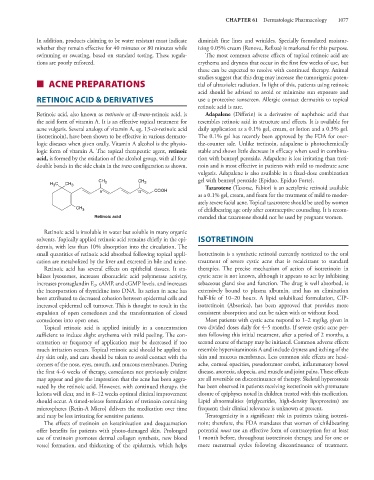Page 1091 - Basic _ Clinical Pharmacology ( PDFDrive )
P. 1091
CHAPTER 61 Dermatologic Pharmacology 1077
In addition, products claiming to be water resistant must indicate diminish fine lines and wrinkles. Specially formulated moistur-
whether they remain effective for 40 minutes or 80 minutes while izing 0.05% cream (Renova, Refissa) is marketed for this purpose.
swimming or sweating, based on standard testing. These regula- The most common adverse effects of topical retinoic acid are
tions are poorly enforced. erythema and dryness that occur in the first few weeks of use, but
these can be expected to resolve with continued therapy. Animal
studies suggest that this drug may increase the tumorigenic poten-
■ ACNE PREPARATIONS tial of ultraviolet radiation. In light of this, patients using retinoic
acid should be advised to avoid or minimize sun exposure and
RETINOIC ACID & DERIVATIVES use a protective sunscreen. Allergic contact dermatitis to topical
retinoic acid is rare.
Retinoic acid, also known as tretinoin or all-trans-retinoic acid, is Adapalene (Differin) is a derivative of naphthoic acid that
the acid form of vitamin A. It is an effective topical treatment for resembles retinoic acid in structure and effects. It is available for
acne vulgaris. Several analogs of vitamin A, eg, 13-cis-retinoic acid daily application as a 0.1% gel, cream, or lotion and a 0.3% gel.
(isotretinoin), have been shown to be effective in various dermato- The 0.1% gel has recently been approved by the FDA for over-
logic diseases when given orally. Vitamin A alcohol is the physio- the-counter sale. Unlike tretinoin, adapalene is photochemically
logic form of vitamin A. The topical therapeutic agent, retinoic stable and shows little decrease in efficacy when used in combina-
acid, is formed by the oxidation of the alcohol group, with all four tion with benzoyl peroxide. Adapalene is less irritating than treti-
double bonds in the side chain in the trans configuration as shown. noin and is most effective in patients with mild to moderate acne
vulgaris. Adapalene is also available in a fixed-dose combination
CH 3 CH gel with benzoyl peroxide (Epiduo, Epiduo Forte).
H 3 C CH 3 3 Tazarotene (Tazorac, Fabior) is an acetylenic retinoid available
9 13 COOH
as a 0.1% gel, cream, and foam for the treatment of mild to moder-
ately severe facial acne. Topical tazarotene should be used by women
CH 3 of childbearing age only after contraceptive counseling. It is recom-
Retinoic acid mended that tazarotene should not be used by pregnant women.
Retinoic acid is insoluble in water but soluble in many organic
solvents. Topically applied retinoic acid remains chiefly in the epi- ISOTRETINOIN
dermis, with less than 10% absorption into the circulation. The
small quantities of retinoic acid absorbed following topical appli- Isotretinoin is a synthetic retinoid currently restricted to the oral
cation are metabolized by the liver and excreted in bile and urine. treatment of severe cystic acne that is recalcitrant to standard
Retinoic acid has several effects on epithelial tissues. It sta- therapies. The precise mechanism of action of isotretinoin in
bilizes lysosomes, increases ribonucleic acid polymerase activity, cystic acne is not known, although it appears to act by inhibiting
increases prostaglandin E , cAMP, and cGMP levels, and increases sebaceous gland size and function. The drug is well absorbed, is
2
the incorporation of thymidine into DNA. Its action in acne has extensively bound to plasma albumin, and has an elimination
been attributed to decreased cohesion between epidermal cells and half-life of 10–20 hours. A lipid solubilized formulation, CIP-
increased epidermal cell turnover. This is thought to result in the isotretinoin (Absorica), has been approved that provides more
expulsion of open comedones and the transformation of closed consistent absorption and can be taken with or without food.
comedones into open ones. Most patients with cystic acne respond to 1–2 mg/kg, given in
Topical retinoic acid is applied initially in a concentration two divided doses daily for 4–5 months. If severe cystic acne per-
sufficient to induce slight erythema with mild peeling. The con- sists following this initial treatment, after a period of 2 months, a
centration or frequency of application may be decreased if too second course of therapy may be initiated. Common adverse effects
much irritation occurs. Topical retinoic acid should be applied to resemble hypervitaminosis A and include dryness and itching of the
dry skin only, and care should be taken to avoid contact with the skin and mucous membranes. Less common side effects are head-
corners of the nose, eyes, mouth, and mucous membranes. During ache, corneal opacities, pseudotumor cerebri, inflammatory bowel
the first 4–6 weeks of therapy, comedones not previously evident disease, anorexia, alopecia, and muscle and joint pains. These effects
may appear and give the impression that the acne has been aggra- are all reversible on discontinuance of therapy. Skeletal hyperostosis
vated by the retinoic acid. However, with continued therapy, the has been observed in patients receiving isotretinoin with premature
lesions will clear, and in 8–12 weeks optimal clinical improvement closure of epiphyses noted in children treated with this medication.
should occur. A timed-release formulation of tretinoin containing Lipid abnormalities (triglycerides, high-density lipoproteins) are
microspheres (Retin-A Micro) delivers the medication over time frequent; their clinical relevance is unknown at present.
and may be less irritating for sensitive patients. Teratogenicity is a significant risk in patients taking isotreti-
The effects of tretinoin on keratinization and desquamation noin; therefore, the FDA mandates that women of childbearing
offer benefits for patients with photo-damaged skin. Prolonged potential must use an effective form of contraception for at least
use of tretinoin promotes dermal collagen synthesis, new blood 1 month before, throughout isotretinoin therapy, and for one or
vessel formation, and thickening of the epidermis, which helps more menstrual cycles following discontinuance of treatment.

